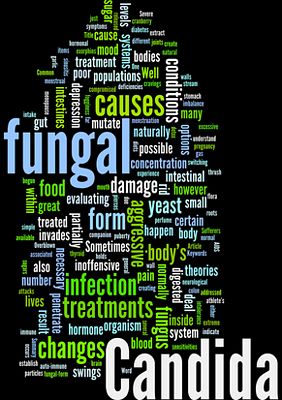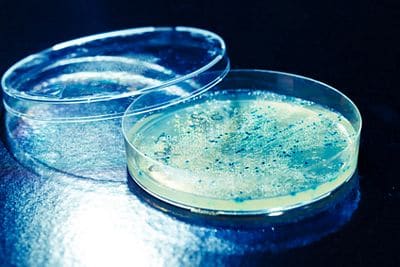
A yeast infection is caused by a specific strain of yeast known as Candida. Although a small amount of yeast is found in the body, a yeast infection occurs when there is an overgrowth of Candida. Most yeast infections are caused by Candida albicans. A yeast infection is a type of fungal infection that affects different areas of the body. Areas affected include the skin, mouth, genitals, throat and blood.
A yeast infection of the skin is often found in skin folds and warm, most areas. This type of yeast infection can cause irritation, itching, inflammation and odor. A yeast infection of the skin oftentimes presents itself as an irritated rash. The rash will appear red and have scalloped edges. The rash may be itchy or painful. Many times parents think their infant has a diaper rash, when in fact the child has a yeast infection.
A yeast infection of the mouth or throat is called oral candidiasis, or thrush. White patches appear on the mouth, lips or elsewhere in the mouth. These patches may look like small milk curds. When the white patch is wiped away, bleeding may occur. Those suffering with thrush may have pain when eating. Thrush is very common in infants because of the changes in hormones experience right after birth.
Invasive candidiasis occurs when Candida enters the blood stream. Patients may experience an atypical fever that does not respond to antibiotic treatment. If the infection spreads to the organs, it can cause serious problems. If the problem is not treated quickly, patients may experience organ failure. Low birth weight infants, patients in intensive care units and those who have a central venous catheter are at a high risk of developing invasive candidiasis. Finally, HIV/AIDS patients often suffer with chronic yeast infections due to a compromised immune system.
The most common type of yeast infection is a vaginal yeast infection. A vaginal yeast infection results in irritation to the vagina and vaginal area and intense itching. Vaginal discharge may be grayish white and have the consistency of cottage cheese. Women may experience burning while urinating due to the irritation of the vaginal area.
There are numerous causes for a Candida overgrowth. Most yeast infections occur after patients take an antibiotic. This is because the antibiotics not only destroys bad bacteria, but also destroys the good lactobacillus bacteria. This bacteria produces acid making the body inhospitable for an overgrowth of yeast. Douching along with irritation can also cause a yeast infection.
Pregnancy is another cause for yeast infections. When women are pregnant, their hormones change. Pregnant women have an increased 
Other medical conditions that can contribute to chronic yeast infections. Uncontrolled diabetes and an impaired immune system can disrupt the good bacteria in the body. Patients using corticosteroids are prone to chronic yeast infections. Finally, yeast infections can be transferred sexually.
Patients who suffer with four or more yeast infections each year are often diagnosed with chronic or recurrent yeast infection. There are many causes for recurrent infections, including uncontrolled diabetes, a compromised immune system and hormonal imbalances.
Are you suffering from chronic yeast infections. Please call us at (571)529-6699 and set up an appointment with our integrative physician.
We gladly serve Northern Virginia including Fairfax, Loudoun, Alexandria, and Prince William counties, Washington DC metro area, and Maryland.
Your BMI score is (Display BMI Score)
Your BMI is in a normal/healthy range for your height (Display Entered HEIGHT) and weight (Display Entered WEIGHT). You are most likely within the recommended weight range for someone of your height, age, and build and consequently are at a lower risk of developing chronic illnesses.
To ensure that you remain at a healthy weight, continue to eat a well-balanced diet that includes plenty of fresh vegetables and fruits, healthy fats, whole grains, low fat dairy products, nuts, beans, eggs, fish, poultry, and lean meat. In addition to a healthy diet, get at least 30 minutes of moderate intensity exercise at least five days a week. For best results, also include strength training exercise at least two days a week.

Your BMI score is (Display BMI Score)
Your BMI is in an Overweight range for your height (Display Entered HEIGHT) and weight (Display Entered WEIGHT).

Typically, those with a higher BMI have more body fatness. Being overweight, you are at an increased risk of a number of health conditions and diseases, including:
It is advisable you speak with your integrative healthcare provider about the best weight loss approach for your unique health, dietary needs, and physical activity levels. Our health coach can work with you to set actionable and realistic goals and help you get started on your journey to optimum health.

For healthy and sustainable weight loss, you may need a combination of increased physical activity and calorie restriction. When substantial weight loss is necessary to reduce the risk of serious illness or death, significant lifestyle changes must be embraced. This includes some stress management techniques like yoga, tai chi, meditation, deep breathing exercises, and guided imagery.
Exercise is essential when it comes to weight loss. As with any activity, you should begin slowly and work your way up to more challenging fitness routines. Experts typically recommend low impact cardio exercises like walking or swimming. In addition to aerobic exercises, try to incorporate strength training exercises into your workout routine.
Having an elevated BMI increases your risk of illness and disease. Reducing your weight through diet and exercise decreases your risk of disease. In addition to this, reducing your overall weight increases your energy levels. As your energy levels increase, you will be able to perform more exercise, which will further improve your weight loss efforts, and as you begin to lose weight, you will feel better about yourself and your self-esteem will begin to improve
Your BMI score is (Display BMI Score)
Your BMI is in a Obese range for your height (Display Entered HEIGHT) and weight (Display Entered WEIGHT).

Typically, those with a higher BMI have more body fatness. Being obese, you are at an increased risk of a number of health conditions and diseases, including:
It is advisable you speak with your integrative healthcare provider about the best weight loss approach for your unique health, dietary needs, and physical activity levels. Our health coach can work with you to set actionable and realistic goals and help you get started on your journey to optimum health.

For healthy and sustainable weight loss, you may need a combination of increased physical activity and calorie restriction. When substantial weight loss is necessary to reduce the risk of serious illness or death, significant lifestyle changes must be embraced. This includes some stress management techniques like yoga, tai chi, meditation, deep breathing exercises, and guided imagery.
Exercise is essential when it comes to weight loss. As with any activity, you should begin slowly and work your way up to more challenging fitness routines. Experts typically recommend low impact cardio exercises like walking or swimming. In addition to aerobic exercises, try to incorporate strength training exercises into your workout routine.
Having an elevated BMI increases your risk of illness and disease. Reducing your weight through diet and exercise decreases your risk of disease. In addition to this, reducing your overall weight increases your energy levels. As your energy levels increase, you will be able to perform more exercise, which will further improve your weight loss efforts, and as you begin to lose weight, you will feel better about yourself and your self-esteem will begin to improve.
Your BMI score is (Display BMI Score)
Your BMI is in a Underweight range for your height (Display Entered HEIGHT) and weight (Display Entered WEIGHT).

If is advisable you speak with your integrative healthcare provider about managing your weight for your unique health, dietary needs, and physical activity levels.
Our health coach can work with you to set actionable and realistic goals and help you get started on your journey to optimum health.